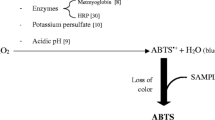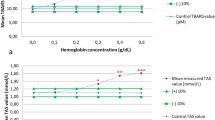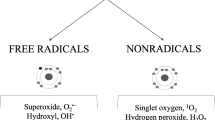Abstract
An high level of ROS (Reactive Oxygen Species), due to an increased production of oxidant species and/or a decreased efficacy of antioxidant system, can lead to oxidative stress, an emerging health risk factor involved in the aging and in many diseases, including inflammatory, infectious and degenerative disorders, either in humans or in animals. In the last years some assays panels have been developed to globally evaluate the oxidative balance by means of the concomitant assessment of ROS production and antioxidant system capability. In this report, the validation trials of d-ROMs (Reactive Oxygen Metabolites— derived compounds) and BAP (Biological Antioxidant Potential) tests in canine specie are described and also the specific referral ranges are calculated in a Labrador population. The results of linearity, precision and accuracy trials show that both tests exhibit good to excellent analytical performances. The possibility of measuring oxidative stress in vivo with simple, cheap and accurate tests, d-ROMs test and BAP test, provides for the veterinarians a very suitable tool to monitor oxidative stress and to correctly choice of eventual antioxidant supplementations in diseases proven related to oxidative stress in animals and particularly in dogs. Further studies will be useful to confirm this possibility.
Similar content being viewed by others
References
Alberti, A., Bolognini, L., Macciantelli, D. and Carratelli M., 2000. The radical cation of N,N-diethyl-para-phenylendiamine: a possibile indicatopr of oxidative stress in biological samples, Research of Chemical Intermediates, 26(3):253–67
Ballerini, A., Civitareale, C., Fiori, M., Regini, M., Brambilla G., 2003. Traceability of inbred and crossbred Cinta Senese Pigs by evaluating the oxidative stress. Journal of Veterinary Medicine A. 50(3):113
Banfi, G., Malavazos, A., Iorio, E., Dolci, A., Doneda L., Verna R.and Corsi M. M., 2006. Plasma oxidative stress biomarkers, nitric oxide and heat shock protein 70 in trained elite soccer players, European Journal of Applied Physiology, 96(5):483–6
Benzie, I.F.F., and Strain, J.J., 1996. The ferric redicing ability of plasma (FRAP) as a measure of “antioxidant power”: the FRAP assay. Analytical Biochemistry., 239:70–76
Bildik, A., Kargin, F., Syrek, K., Pasa, S., Ozensoy, S., 2004. Oxidative stress and non-enzymatic antioxidative status in dogs with visceral Leishmaniasis, Research in Veterinary Science, 77(1):63–6
Brambilla, G., Ballerini, A., Civitareale, C., Fiori, M., Ner, B., Cavallina, R., Nardoni, A. and Riannetti, L., 2003. Oxidative stress as a bio-marker of estrogen exposure in healthy veal calves. Analytica Chimica Acta, 483:281–288
Cavalleri, A., Colombo, C., Venturelli, E., Miceli, R., Mariani, L., Cornelli, U., Pala, V., Berrino, F. and Secreto, G., 2004. Evaluation of reactive oxygen metabolites in frozen serum samples. Effect of storage and repeated thawing,. The International Journal of Biological Markers, 18(3):250–3
Colombo, C., Muti, P., Pala, V., Cavalleri, A., Venturelli, A., Locardi, M., Berrino, F. and Secreto G., 2005. Plant-based diet, serum fatty acid profile, and free radicals in postmenopausal women: the diet and androgens (DIANA) randomized trial. The International Journal of Biological Markers, 20(3):169–76
Cornelli, U., Terranova, S., Luca, S., Cornelli, A. and Alberti A., 2001. Bioavailability and antioxidant activity of some food supplements in men and women using the d-ROMs test as a marker of oxidative stress, Journal of Nutrition, 131(12):3208–11
Dohi K., Satoh K., Ohtaki H., Shioda S., Miyake Y., Shindo M., Aruga T., 2005. Elevated plasma levels of bilirubin in patients with neurotrauma reflect its pathophysiological role in free radical scavenging. In Vivo, 19(5):855–60.
Freeman, L.M., Rush, J.E., Milbury, P.E., Blumberg J.B., 2005. Antioxidant status and biomarkers of oxidative stress in dogs with congestive heart failure, Journal of Veterinary Internal Medicine, 19(4):537–41
Halliwell, B., 1994. Free radicals, antioxidant and human disease: curiosity, cause or consequence, Lancet 344:721–724
Hand, M.S., Thatcher C.D., Remillard R:L:, Roudebush P., 2000. Small Animal Clinical Nutrition 4th Edition Mark Morris Institute, Missouri (USA)
Hetyey, C.S., Manczur, F., Dudas-Gyorky, Z., Reiczigel, J., Ribiczey, P., Vajdovich, P., Voros, K. (2007) Plasma antioxidant capacity in dogs with naturally occurring heart desease, Journal of Veterinary Medicine series A, 54:36–39
Hinhcliff, K.W., Reinhart, G.A., DiSilvestro, R., Reynolds, A., Blostein-Fujii, A., Swenson, R.A., 2000. Oxidant stress in sled dogs subjected to repetitive endurance exercise, American Journal of Veterinary Research, 61(5):512–7
Iamele, L., Fiocchi, R., Vernocchi, A., 2002. Evaluation of an automated spectrophotometric assay for reactive oxygen metabolites in serum., Clinical Chemistry and Laboratory Medicine, 40(7):673–6
Kaneko, J., Harvey, J., Bruss, M., 1997. Clinical Biochemistry of Domestic Animals (Academic Press, London)
Kiral, F., Karagenc, T., Pasa,, Seyrek, K., 2005. Dogs with Hepatozoon canis respond to the oxidative stress by increased production of glutathione and nitric oxide, Veterinary Parasitology, 15;131(1–2):15–21
Kumaraguruparan, R., Balachandran, C., Murali Manohar, B., Nagini, S., 2005. Altered oxidant-antioxidant profile in canine mammary tumours, Veterinary Research Communications, 29:287–296
Murray, W., Peter, T. A., and Teclaw, R. F., 1993. The clinical Relevance of Assay Validation, The Compendium on Continuing Education for the Practicing Veterinarian, 15, 1665–1675
Oriani, G., Corino, C., Pastorelli, G., Pantaleo L., Ritieni, A., Salvatori, G., 2001. Oxidative status of plasma and muscle in rabbits supplemented with dietary vitamin E. Journal of Nutritional Biochemistry, 12:138–143
Sczubial, M., Kankofer, M., Loposzynski, W., Dabrowski, R., Lipko, J., 2004. Oxidative stress parameters in bitches with mammary gland tumours, Journal of Veterinary Medicine A, 51(7–8):336–40
Sivaram, A.G., Suresh, M.V., Indira, M., 2003. Combined effect of ascorbic acid and selenium supplementation on alcohol-induced oxidative stress in guinea pigs. Comparative Biochemistry and Physiology Part C, 134:397–401
Trotti, R., Carratelli, M., Barbieri, M., 2002. Performance and clinical application of a new, fast method for the detection of hydroperoxides in serum, Panminerva Medica, 44(1):37–40
Vajdovich, P., Kriska, T., Mezes, M., Szabo, P.R., Balogh, N., Banfi, A., Arany-Toth, A., Gaal, T., Jakus, J., 2005. Redox status of dogs with non-hodgkin lymphomas. An ESR study, Cancer Letters, 28;224(2):339–46
Vassalle, C., Boni, C., Di Cecco, P., Ndreu, R. and Zucchelli, G:C:, 2006. Automation and validation of a fast method for the assessment of in vivo oxidative stress levels, Clinical Chemistry and Laboratory Medicine, 44(11):1372–5
Author information
Authors and Affiliations
Corresponding author
Rights and permissions
About this article
Cite this article
Pasquini, A., Luchetti, E., Marchetti, V. et al. Analytical performances of d-ROMs test and BAP test in canine plasma. Definition of the normal range in healthy Labrador dogs. Vet Res Commun 32, 137–143 (2008). https://doi.org/10.1007/s11259-007-9014-x
Received:
Accepted:
Published:
Issue Date:
DOI: https://doi.org/10.1007/s11259-007-9014-x




